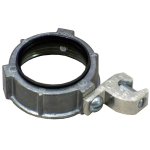I don't think that applies where the supply circuit conductors are in the same ferrous raceway as the EGC. It is my understanding that the additional impedance from the inductive reactance is only where a single conductor of an ac circuit it run through a ferrous raceway. The only example of that that I know of is a grounding electrode conductor in a ferrous raceway.
Your right of course. I thought about the unbonded run of EMT in terms of it getting bonded to the Equipment Grounding Conductor (EGC) of a different branch circuit from the same panelboard which would be truly unlikely to be done here. Its a defective installation that needs to be repaired and not just bonded to some other bonding point. Replacing the L condulet with a metal box or just adding a metal box between the condulet and the smurf tube would do the job.
That doesn't apply here. I was remembering a caution that was given to us here, during continuing education class, about using the Equipment Grounding Conductor of another circuit from the same panel when bonding the non current carrying conductive parts of receptacle replacement or circuit extensions under Article:
250.130 Equipment Grounding Conductor Connections.
(B). For replacement of non–grounding-type receptacles with
grounding-type receptacles and for branch-circuit extensions
only in existing installations that do not have an equipment
grounding conductor in the branch circuit, connections shall
be permitted as indicated in 250.130(C).
(C) Nongrounding Receptacle Replacement or Branch Circuit
Extensions. The equipment grounding conductor of a
grounding-type receptacle or a branch-circuit extension shall
be permitted to be connected to any of the following
(4) An equipment grounding conductor that is part of
another branch circuit that originates from the enclosure
where the branch circuit for the receptacle or branch
circuit originates
This specific concern arises out of a circuit extension done with a Ferrous metal cable jacket or raceway which is then bonded to the EGC of a different branch circuit. An example would be the replacement of non grounding receptacles with the grounded type when the circuit extension supplying those receptacles does not have a EGC of any type. Such extended circuits would include the original Rome Wire and Cable "Romex type NM cable that did not include an EGC, and Knob and Tube wiring.
Under that condition you do have the Equipment Grounding/(Bonding) Conductor of that other branch circuit and the Energized Conductor of the circuit supplying the Replacement Receptacle or Circuit Extension carrying current in one direction only without the cancellation effect of either conductor being in the same raceway. If the improperly installed circuit is not repaired then the actual risk would be that the EMT portion of the run might become energized without it having the required low impedance pathway back to the source of the current.
Now, thanks to your help, i can see that It wouldn't be required or even necessary to bond the EMT at the equipment end. That said would you do it anyway. I know I would at least be tempted to finish it with a bonding bushing and drop the wire EGC into the lay in lug.
I've just gotta keep better notes from those continuing education classes and review them a couple of times afterwards to keep the ideas straight in my head.
Tom Horne

